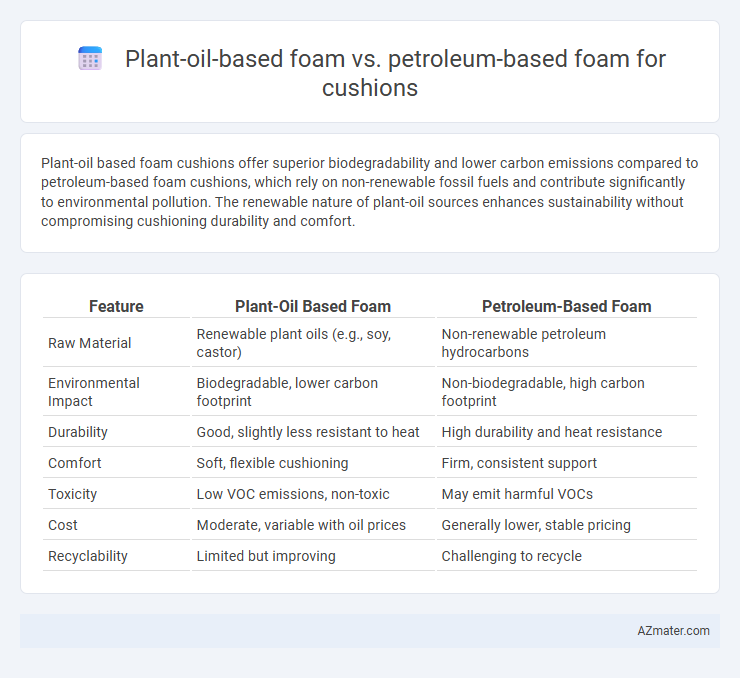Plant-oil based foam cushions offer superior biodegradability and lower carbon emissions compared to petroleum-based foam cushions, which rely on non-renewable fossil fuels and contribute significantly to environmental pollution. The renewable nature of plant-oil sources enhances sustainability without compromising cushioning durability and comfort.
Table of Comparison
| Feature | Plant-Oil Based Foam | Petroleum-Based Foam |
|---|---|---|
| Raw Material | Renewable plant oils (e.g., soy, castor) | Non-renewable petroleum hydrocarbons |
| Environmental Impact | Biodegradable, lower carbon footprint | Non-biodegradable, high carbon footprint |
| Durability | Good, slightly less resistant to heat | High durability and heat resistance |
| Comfort | Soft, flexible cushioning | Firm, consistent support |
| Toxicity | Low VOC emissions, non-toxic | May emit harmful VOCs |
| Cost | Moderate, variable with oil prices | Generally lower, stable pricing |
| Recyclability | Limited but improving | Challenging to recycle |
Introduction to Cushion Foams: Plant-Oil vs Petroleum-Based
Cushion foams derived from plant oils offer a sustainable alternative to traditional petroleum-based foams, reducing environmental impact through renewable raw materials like soy and castor oil. Plant-oil foams exhibit comparable cushioning properties, durability, and comfort while emitting fewer volatile organic compounds (VOCs) during production and use. In contrast, petroleum-based foams rely on non-renewable fossil fuels, contributing to higher carbon footprints and greater ecological concerns in the manufacturing and disposal processes.
Raw Material Sourcing: Renewable vs Non-Renewable Origins
Plant-oil based foam for cushions is derived from renewable sources such as soy, castor, or sunflower oils, which contribute to sustainable raw material sourcing and reduce carbon footprint. Petroleum-based foam relies on non-renewable fossil fuels, leading to greater environmental impact due to finite resource depletion and higher greenhouse gas emissions. The renewable origins of plant-oil based foam support circular economy principles and promote eco-friendly product life cycles compared to the traditional petroleum-derived counterparts.
Environmental Impact: Carbon Footprint and Sustainability
Plant-oil based foam for cushions significantly reduces the carbon footprint due to its renewable biomass origin, unlike petroleum-based foam which relies on finite fossil fuels contributing to higher greenhouse gas emissions. The biodegradable nature of plant-oil foams enhances sustainability by minimizing landfill waste and promoting circular economy principles, whereas petroleum-based foams persist in the environment for decades. Life cycle assessments consistently show plant-oil foams have lower overall environmental impacts, including reduced energy consumption and resource depletion, aligning with eco-friendly manufacturing standards.
Chemical Composition and Safety Profiles
Plant-oil based foam for cushions primarily consists of bio-based polyols derived from natural oils such as soybean or castor oil, reducing reliance on petrochemicals and enhancing biodegradability. Petroleum-based foam is synthesized from petrochemical polyols and isocyanates, often containing higher levels of volatile organic compounds (VOCs) that can pose indoor air quality risks. Safety profiles favor plant-oil based foam due to lower toxicity, reduced flammability, and diminished emission of harmful substances, making it a more sustainable and health-conscious choice for upholstery applications.
Comfort, Performance, and Durability Comparison
Plant-oil based foam offers superior breathability and pressure relief, enhancing overall comfort compared to petroleum-based foam, which tends to retain heat, causing discomfort during prolonged use. In terms of performance, plant-oil foam exhibits greater elasticity and faster recovery, providing consistent support, while petroleum-based foam may compress over time, reducing cushioning effectiveness. Durability assessments show that plant-oil foam resists degradation and maintains structural integrity longer, contributing to eco-friendly sustainability without compromising lifespan, whereas petroleum-based foam often degrades faster due to oxidative wear.
Manufacturing Processes and Energy Consumption
Plant-oil based foam manufacturing involves bio-based polyols derived from renewable resources such as soybean or castor oil, which reduces dependency on fossil fuels and lowers greenhouse gas emissions. This process typically consumes less energy compared to petroleum-based foam production, as it requires fewer refining steps and utilizes greener chemical reactions. Energy consumption in petroleum-based foam manufacturing is higher due to extensive extraction, refining, and processing of crude oil, contributing significantly to the carbon footprint of cushion materials.
Cost Analysis: Production, Distribution, and End-Use
Plant-oil based foam typically incurs higher production costs due to the expense of raw materials and more complex processing techniques compared to petroleum-based foam, which benefits from established supply chains and cheaper fossil fuel inputs. Distribution expenses for plant-oil foam can be slightly higher because of limited manufacturing locations and lower economies of scale, while petroleum-based foam enjoys widespread production facilities and streamlined logistics. End-use costs also favor petroleum-based foams, as their durability and lower initial price often outweigh the environmental and health benefits offered by plant-oil alternatives in consumer cushioning products.
Health Considerations: Allergens and Off-Gassing
Plant-oil based foams typically emit fewer volatile organic compounds (VOCs) compared to petroleum-based foams, significantly reducing off-gassing and indoor air pollution. These eco-friendly foams often contain fewer allergens and irritants, making them a safer choice for individuals with chemical sensitivities or respiratory issues. In contrast, petroleum-based foams release higher levels of off-gassing chemicals, such as formaldehyde and benzene, which may exacerbate allergies and pose long-term health risks.
Market Trends and Consumer Preferences
Plant-oil based foam for cushions is rapidly gaining market share due to increasing consumer demand for sustainable and eco-friendly materials, driven by heightened awareness of environmental impact. Recent trends show significant growth in regions with strong green policies, where plant-based foams offer biodegradability and lower carbon footprints compared to traditional petroleum-based counterparts. Consumers prioritize non-toxic, renewable resource content and improved indoor air quality, fueling a shift towards plant-oil alternatives in home and commercial cushioning products.
Future Prospects: Innovations in Cushion Foam Technology
Plant-oil based foam offers promising sustainability advantages over petroleum-based alternatives, driven by advancements in bio-polyol extraction and green chemistry. Innovations in cushion foam technology focus on enhancing durability, comfort, and biodegradability through hybrid blends and nanocellulose reinforcement. Future prospects highlight scaling up eco-friendly production methods to meet increasing consumer demand for renewable cushioning materials.

Infographic: Plant-oil based foam vs Petroleum-based foam for Cushion
 azmater.com
azmater.com